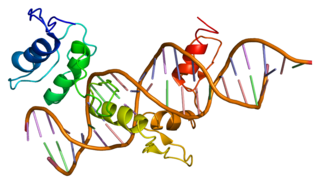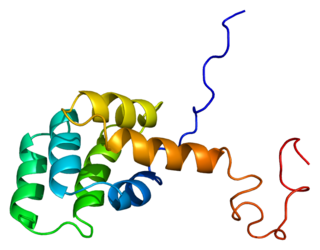Growth arrest-specific protein 1 is a protein that in humans is encoded by the GAS1 gene. [5] [6]
Growth arrest-specific protein 1 is a protein that in humans is encoded by the GAS1 gene. [5] [6]
Growth arrest-specific 1 plays a role in growth suppression. GAS1 blocks entry to S phase and prevents cycling of normal and transformed cells. Gas1 is a putative tumor suppressor gene. [6]
The mouse cells, which appear the growth-arrested, were observed expression of Growth Arrest Specific-1 gene (GAS1). [5] In 1988, Gas-1 was first defined as one of six genes that block transcriptional up-regulation of the NIH3T3 cell cycle from G0 to S phase. [6] Most of scientist have proved that overexpressed gas1 has the function of inhibiting tumor growth and progression in gliomas. Furthermore, GAS1 gene was also thought to contribute to recurrence and metastasized prediction in colon cancer.
GAS-1 gene has been identified as a putative tumor suppressor collocates on chromosome 9q21.3-22.1 where was considered to be a fragile site. [7] In 1994, 29 metaphases were analyzed by Del Sal et al, and 102 fluorescent signals were observed during the experiment. The results showed that 84 (82%) expression rate of the fluorescent signal on chromosome 9. [8] Furthermore, the peak signal density of the fluorescent also observed occurring in the q21.3-22.1 region. [8] In addition, the inexpression of the fluorescent signal cluster on any other chromosome further demonstrates Gas1 gene specifically expresses on chromosome 9q21.3-22.1. [8]
345 amino acids were confirmed to constitute mature Gas-1 gene. Asn117 and an aminated Ser318 are two particular position which result in discovering of the one N-glycosylation site and potential signal peptide, respectively. [9]
Gas-1 gene has been confirmed to be highly similar to the GFRα1 gene (28% similarity) while the Gas1 only consists of two domains which is different from the GFRα1-3 that composes of three domains. [10] [11] Although the structure of GAS1 gene is similar to GFRαs, the function of GAS1 is largely different from GFRαs since the GAS 1 gene has the ability of binding RET in a ligand independent manner. [11] [12] Since the structure similarity between GAS1 and GFRαs, the ancestor of GFRα proteins was suspected to be the GAS1. [12] In regard to the secondary structure, most of mammalian Gas1 gene’s secondary structure were identified to be mostly α-helical and to have a long unstructured C-terminal domain [10]
GAS1 protein widespread distributed in adult mammalian CNS ( central nervous system). Adult mouse brain has been described expressing GAS1 mRNA, and the experiment of Natanael Zarco et al further corroborated this description. [13] Western blot analysis is the main method which has been used in their practical and plays an significant role in successfully determining the distribution of the protein in the adult central nervous system (CNS). [13] Olfactory bulb, caudate-putamen, cerebral cortex, hippocampus, mesencephalon, medulla oblongata, cerebellum, and cervical spinal cord has been identified as the specific expression parts of GAS1. [13] Despite the pattern of expression in Astrocyte cells was more limited than in neurons, the gas1 was also found expressing in that part.
GAS1 was identified as a pleiotropic protein with the function of cell arrest and apoptosis. GAS1 can induce intrinsic apoptosis; this pathway does not involve the activity of caspase 8. [14] GAS1 accomplishes this by inhibiting GDNF-induced phosphorylation of RET, which leads to decreased phosphorylation of AKT; this decrease facilitates the dephosphorylation of BAD, which triggers the release of cytochrome c from the mitochondria and subsequent formation of the apoptosome, ultimately resulting in apoptosis. [14]
Except that, the nervous system and other amount of organs can also be largely influenced by the abnormal Gas1 gene. The reason of this dual function is likely caused by its ability of interacting with the inhibited signaling cascade which induced by GNDF (glial cell-line derived neurotrophic factor). [13] Additionally, GAS1 has been proved can largely influence the developmental state of the organs. [15] During the development stage of the GAS1, it has been suggested that development GAS1 can not only inhibit cell proliferation but also control the cell death as well as growth of the cerebellum. [9] The signal emission of GAS 1 protein associate with two different types of transmembrane receptor protein, including RET and the Hedgehog receptor protein, [16] GAS1 is therefore determined as a kind of multifunctional protein. The Hedgehog signaling pathway is known as an essential part in the body which largely influences the body development, and cancer progression since the Sonic hedgehog can be connected by GAS1 directly, and lead to active of the signaling pathway. [17]
The GAS1 gene plays a significant role in kidney development. Conserved DNA binding motif, which is located in the Gas1 promoter, is directly bind by the WT1, and then the Gas1 mRNA is activated to transcript to the NPCs. [18] The WT1 has been confirmed as a necessary part for expressing Gas1 in kidneys in vivo. Loss of function of GAS1 in vivo results in hypoplastic kidneys with reduced nephron mass due to premature depletion of NPCs. [18] In humans, fetal period is the most significant time point for inducting a new nephrons, no matter what kind of mammals, once the NPCS disappeared, there is no possibility for inducing the new nephrons. [18]
Gas1 gene has been mapped by the method of in situ hybridization to human chromosome bands 9q21.3-q22, [8] a fragile site where frequently deleted in human tumors, especially acute myeloid leukemia and bladder tumors. [19] The deletion region of early superficial bladder cancer indicated that the frequent (50%) deletion of tumor suppressor genes was located between 9q22 and 9p12-13, an area that spanned the GAS1 gene position and could be a starting event for bladder cancer disease. [20] However, a study that has been done by Simoneau et al indicates that there is no mutations in the gas1 gene in 14 primary bladder carcinomas and 10 bladder carcinoma cell lines, which means the mutation of gas1 is not the main reason in causing the pathogenesis.

An oncogene is a gene that has the potential to cause cancer. In tumor cells, these genes are often mutated, or expressed at high levels.

In cellular biology, paracrine signaling is a form of cell signaling, a type of cellular communication in which a cell produces a signal to induce changes in nearby cells, altering the behaviour of those cells. Signaling molecules known as paracrine factors diffuse over a relatively short distance, as opposed to cell signaling by endocrine factors, hormones which travel considerably longer distances via the circulatory system; juxtacrine interactions; and autocrine signaling. Cells that produce paracrine factors secrete them into the immediate extracellular environment. Factors then travel to nearby cells in which the gradient of factor received determines the outcome. However, the exact distance that paracrine factors can travel is not certain.

Zinc finger protein GLI1 also known as glioma-associated oncogene is a protein that in humans is encoded by the GLI1 gene. It was originally isolated from human glioblastoma cells.

The Fas receptor, also known as Fas, FasR, apoptosis antigen 1, cluster of differentiation 95 (CD95) or tumor necrosis factor receptor superfamily member 6 (TNFRSF6), is a protein that in humans is encoded by the FAS gene. Fas was first identified using a monoclonal antibody generated by immunizing mice with the FS-7 cell line. Thus, the name Fas is derived from FS-7-associated surface antigen.

Interleukin 24 (IL-24) is a protein in the interleukin family, a type of cytokine signaling molecule in the immune system. In humans, this protein is encoded by the IL24 gene.

Protein kinase C delta type is an enzyme that in humans is encoded by the PRKCD gene.

Death receptor 4 (DR4), also known as TRAIL receptor 1 (TRAILR1) and tumor necrosis factor receptor superfamily member 10A (TNFRSF10A), is a cell surface receptor of the TNF-receptor superfamily that binds TRAIL and mediates apoptosis.

DnaJ homolog subfamily A member 3, mitochondrial, also known as Tumorous imaginal disc 1 (TID1), is a protein that in humans is encoded by the DNAJA3 gene on chromosome 16. This protein belongs to the DNAJ/Hsp40 protein family, which is known for binding and activating Hsp70 chaperone proteins to perform protein folding, degradation, and complex assembly. As a mitochondrial protein, it is involved in maintaining membrane potential and mitochondrial DNA (mtDNA) integrity, as well as cellular processes such as cell movement, growth, and death. Furthermore, it is associated with a broad range of diseases, including neurodegenerative diseases, inflammatory diseases, and cancers.

Psychosine receptor is a G protein-coupled receptor (GPCR) protein that in humans is encoded by the GPR65 gene. GPR65 is also referred to as TDAG8.

Inhibitor of growth protein 1 is a protein that in humans is encoded by the ING1 gene.

Secreted frizzled-related protein 1, also known as SFRP1, is a protein which in humans is encoded by the SFRP1 gene.

Decoy receptor 3 (Dcr3), also known as tumor necrosis factor receptor superfamily member 6B (TNFRSF6B), TR6 and M68, is a soluble protein of the tumor necrosis factor receptor superfamily which inhibits Fas ligand-induced apoptosis.

MDS1 and EVI1 complex locus protein EVI1 (MECOM) also known as ecotropic virus integration site 1 protein homolog (EVI-1) or positive regulatory domain zinc finger protein 3 (PRDM3) is a protein that in humans is encoded by the MECOM gene. EVI1 was first identified as a common retroviral integration site in AKXD murine myeloid tumors. It has since been identified in a plethora of other organisms, and seems to play a relatively conserved developmental role in embryogenesis. EVI1 is a nuclear transcription factor involved in many signaling pathways for both coexpression and coactivation of cell cycle genes.

MAP kinase-activating death domain protein is an enzyme that in humans is encoded by the MADD gene.

Fibroblast growth factor 4 is a protein that in humans is encoded by the FGF4 gene.

Tumor necrosis factor receptor superfamily member 12A also known as the TWEAK receptor (TWEAKR) is a protein that in humans is encoded by the TNFRSF12A gene.
A metastasis suppressor is a protein that acts to slow or prevent metastases from spreading in the body of an organism with cancer. Metastasis is one of the most lethal cancer processes. This process is responsible for about ninety percent of human cancer deaths. Proteins that act to slow or prevent metastases are different from those that act to suppress tumor growth. Genes for about a dozen such proteins are known in humans and other animals.

Fibroblast growth factor 6 is a protein that in humans is encoded by the FGF6 gene.
Anticancer genes, when expressed ectopically, exhibit a preferential ability to kill cancer cells while leaving normal healthy cells unharmed. This phenomenon is achieved through various processes such as apoptosis, apoptosis following a mitotic catastrophe, necrosis, and autophagy. In the late 1990s, extensive research in the field of cancer cells led to the identification of many anticancer genes such as '291 The human genome'. The deregulation of these genes due to base substitutions leading to insertions, deletions, or alterations in missense amino acids can cause frameshifts, thereby altering the protein. A change in gene copy number or rearrangements is also essential for deregulating these genes. The loss or alteration of these anticancer genes due to mutations or rearrangements may lead to the development of cancer.(1)